Incomplete rematching of nerve and muscle properties in motor units after extensive nerve injuries in cat hindlimb muscle
- PMID: 9596809
- PMCID: PMC2231005
- DOI: 10.1111/j.1469-7793.1998.909bm.x
Incomplete rematching of nerve and muscle properties in motor units after extensive nerve injuries in cat hindlimb muscle
Abstract
1. Motor units were characterized in partially denervated or completely denervated and reinnervated cat medial gastrocnemius (MG) muscles where the number of innervating motor axons was severely reduced to determine (1) to what extent the nerve and muscle properties are rematched in enlarged motor units, (2) whether the normal size relationships between axon size, unit tetanic force and contractile speed are re-established, and (3) whether the type of nerve injury and/or repair affects the re-establishment of nerve and muscle properties. 2. Single MG units were sampled in (1) partially denervated muscles and in reinnervated muscles after either (2) crushing or (3) transecting the nerve and suturing its proximal end to either the distal nerve stump (N-N), or (4) directly to the muscle fascia (N-M). 3. The majority (75-88 %) of motor units in all muscles were classified as S (slow), FR (fast fatigue resistant), FI (fast fatigue intermediate) and FF (fast fatigable). However, there was an increased number of FI and unclassifiable motor units compared to normal. These results suggest that motor unit properties are not entirely regulated by the reinnervating motoneurone. 4. Despite more overlap in the range of unit force between different motor unit types the tetanic force of each type increased in all muscles when reinnervated by few (< 50 %) motor axons. This increase in unit force was due to an expansion in motor unit innervation ratio. 5. The normal relationships between axon size, unit tetanic force, and contractile speed were re-established in all muscles except when reinnervated by < 50 % of their normal complement of motor units after N-M suture. This lack of correlation was due to the reduced fast glycolytic (FG) fibre size and the proportionately greater increase in force of the S units. 6. After reinnervation the ranges in fibre cross-sectional area within single FF units were very similar to those found within the entire FG fibre population. 7. These results show that when few axons make functional connections in partially denervated or reinnervated muscles the normal relationships between axon size and motor unit contractile properties are re-established provided the nerves regenerate within the distal nerve sheath. This rematching of motoneurone size and motor unit contractile properties occurs primarily because the size of the motor axon governs the number of muscle fibres it supplies.
Figures
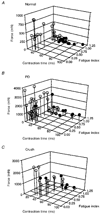


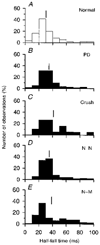
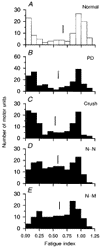

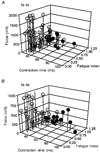

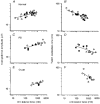
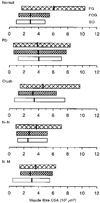


Similar articles
-
Self-reinnervated cat medial gastrocnemius muscles. I. comparisons of the capacity for regenerating nerves to form enlarged motor units after extensive peripheral nerve injuries.J Neurophysiol. 1996 Jan;75(1):268-81. doi: 10.1152/jn.1996.75.1.268. J Neurophysiol. 1996. PMID: 8822556
-
Self-reinnervated cat medial gastrocnemius muscles. II. analysis of the mechanisms and significance of fiber type grouping in reinnervated muscles.J Neurophysiol. 1996 Jan;75(1):282-97. doi: 10.1152/jn.1996.75.1.282. J Neurophysiol. 1996. PMID: 8822557
-
Comparison of physiological and histochemical properties of motor units after cross-reinnervation of antagonistic muscles in the cat hindlimb.J Neurophysiol. 1988 Jul;60(1):365-78. doi: 10.1152/jn.1988.60.1.365. J Neurophysiol. 1988. PMID: 2969959
-
The resilience of the size principle in the organization of motor unit properties in normal and reinnervated adult skeletal muscles.Can J Physiol Pharmacol. 2004 Aug-Sep;82(8-9):645-61. doi: 10.1139/y04-081. Can J Physiol Pharmacol. 2004. PMID: 15523522 Review.
-
Comparison of injury and development in the neuromuscular system.Ciba Found Symp. 1988;138:210-26. doi: 10.1002/9780470513675.ch13. Ciba Found Symp. 1988. PMID: 3058429 Review.
Cited by
-
Hemihypoglossal-facial nerve anastomosis: results and electromyographic characterization.Eur Arch Otorhinolaryngol. 2022 Jan;279(1):467-479. doi: 10.1007/s00405-021-06893-4. Epub 2021 May 25. Eur Arch Otorhinolaryngol. 2022. PMID: 34036422
-
Polysialylated neural cell adhesion molecule is necessary for selective targeting of regenerating motor neurons.J Neurosci. 2005 Feb 23;25(8):2081-91. doi: 10.1523/JNEUROSCI.4880-04.2005. J Neurosci. 2005. PMID: 15728848 Free PMC article.
-
Synkinesis following recurrent laryngeal nerve injury: A computer simulation.Laryngoscope. 2016 Jul;126(7):1600-5. doi: 10.1002/lary.25730. Epub 2015 Nov 24. Laryngoscope. 2016. PMID: 26600293 Free PMC article.
-
Neuromuscular Activity Determines, at Least in Part, the Motoneuron, Nerve and Muscle Properties Under Normal Conditions and After Nerve Injury.Int J Mol Sci. 2025 Jul 17;26(14):6891. doi: 10.3390/ijms26146891. Int J Mol Sci. 2025. PMID: 40725136 Free PMC article. Review.
-
Fatigue properties of human thenar motor units paralysed by chronic spinal cord injury.J Physiol. 2006 May 15;573(Pt 1):161-71. doi: 10.1113/jphysiol.2005.103044. Epub 2006 Mar 2. J Physiol. 2006. PMID: 16513673 Free PMC article.
References
-
- Bodine SC, Roy RR, Eldred E, Edgerton VR. Maximal force as a function of anatomical features of motor units in the cat tibialis anterior. Journal of Neurophysiology. 1987;57:1730–1745. - PubMed
-
- Boyd IA, Davey MR. Composition of Peripheral Nerves. London: Livingston; 1968.
-
- Brooke MH, Kaiser KK. Three ‘myosin adenosine triphosphatase’ systems: the nature of their pH lability and sulfhydryl dependence. Journal of Histochemistry and Cytochemistry. 1970;19:670–672. - PubMed
Publication types
MeSH terms
LinkOut - more resources
Full Text Sources
Medical
Miscellaneous

